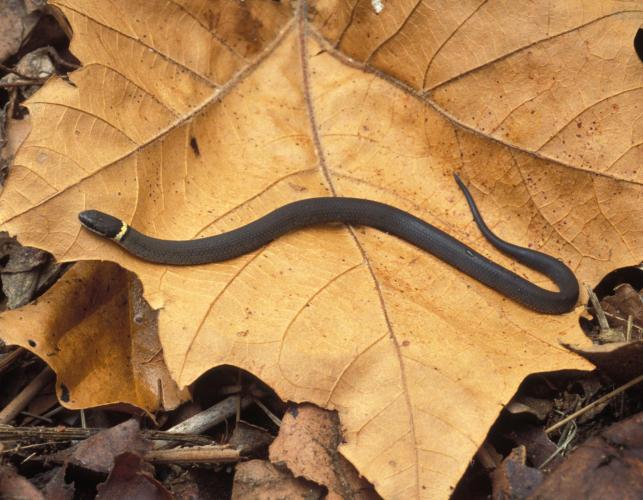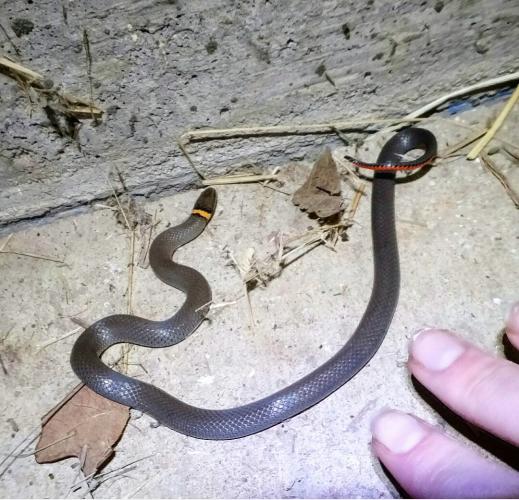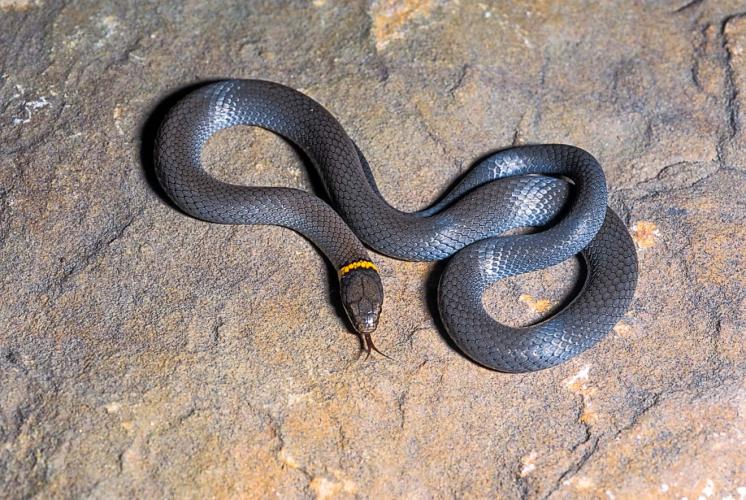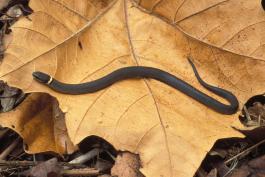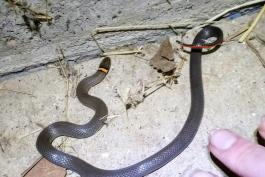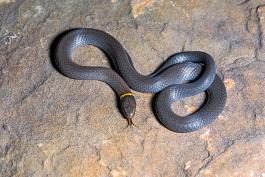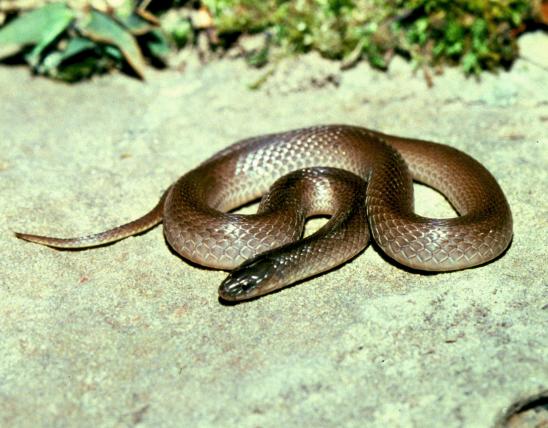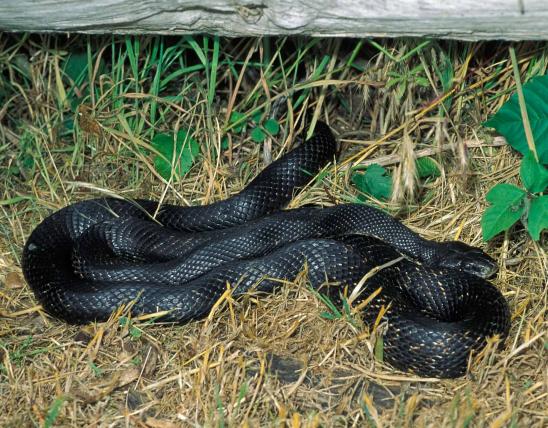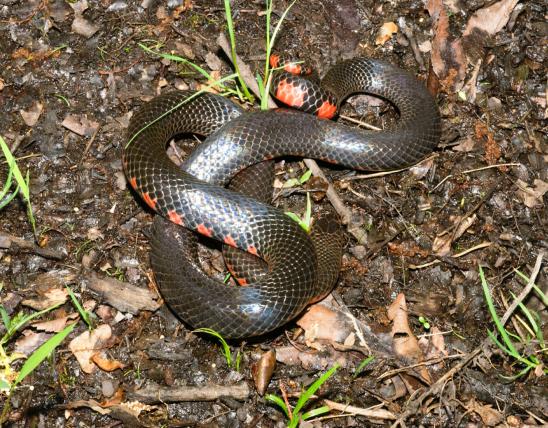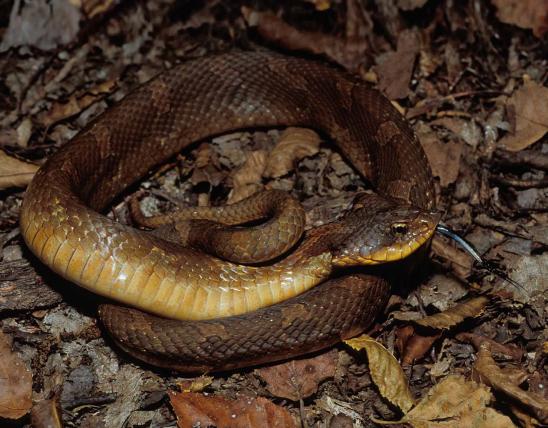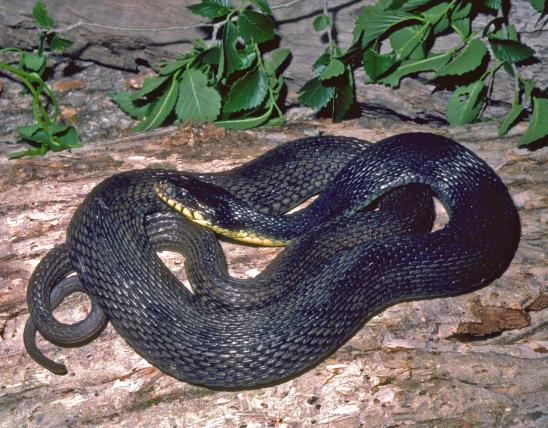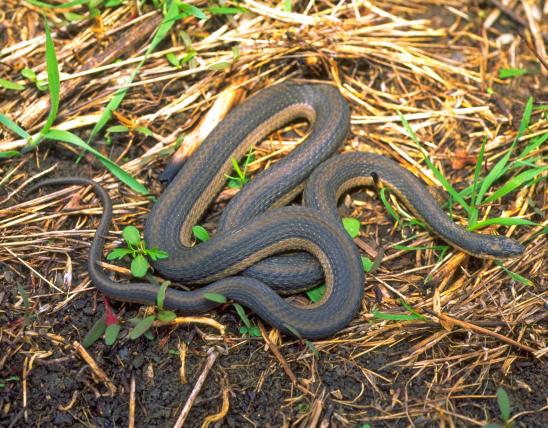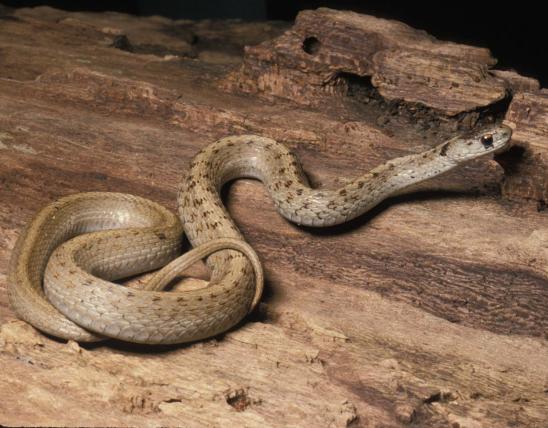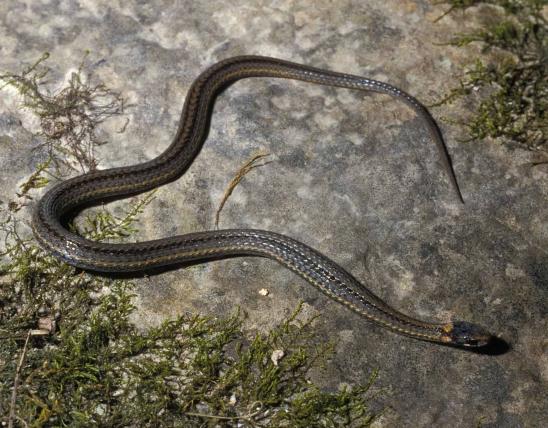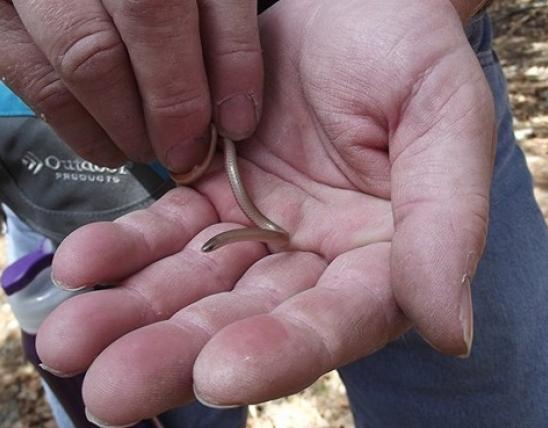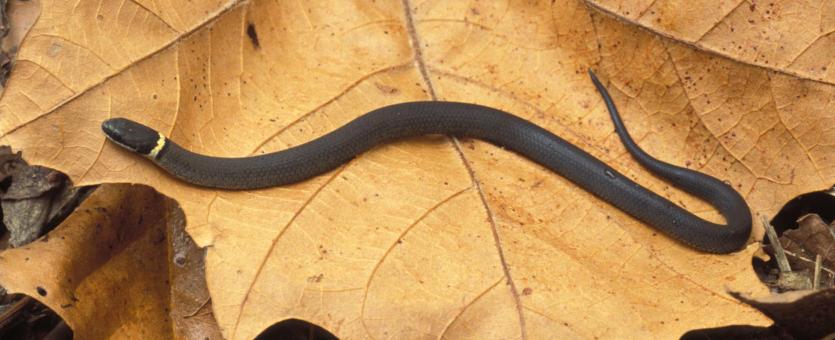
Prairie ring-necked snakes are easily recognizable by their small size, uniform dark color on the back, bright yellow-orange belly, and distinct yellow ring around the neck.
The prairie ring-necked snake is a small, dark snake with a yellow or orange ring around the neck that is one or two scale rows wide and usually has a hind edge of black. The upperside (dorsal) color is normally shiny dark gray but may be gray brown. The top of the head is usually darker than the body. The belly is yellow with numerous irregularly placed, small black spots; the belly changes to a bright orange or red along the underside of the tail. The body scales are smooth; the anal plate (last belly scale, which covers the anal opening) is divided.
Young ring-necked snakes have a darker dorsal color, which is often shiny black.
When first uncovered, a specimen may tightly coil its tail and expose its brightly colored underside to draw attention away from its head. This small snake is not known to bite a person, but when first handled and alarmed, it will discharge a pungent, unpleasant musk mixed with fecal matter.
Similar species: In all, ring-necked snakes of the Diadophis punctatus lineage contain 12 subspecies or geographic races. The prairie ring-necked snake, described above, is the most common and widespread of Missouri's two subspecies. The Mississippi ring-necked snake (D. punctatus stictogenys) is the subspecies found in southeastern Missouri. It is slightly smaller, its yellow neck ring may be narrower or interrupted (broken) on the back, it has a yellow belly, and the small black belly spots are usually in 2 or 3 lengthwise rows. Where the ranges of our two subspecies overlap (in a two-county-wide, northeast-to-southwest line from Perry and Cape Girardeau counties to Carter and Ripley counties), there is a potential area of intergradation between the two races, and individuals in that zone may show characteristics of both subspecies.
Adult length: 10 to 15 inches; occasionally to 28 inches. Adult males are smaller than females.
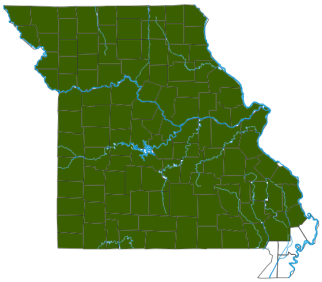
Nearly statewide. The Mississippi ring-necked snake subspecies replaces the prairie subspecies in the Bootheel. There is a potential zone of intergradation between the two races just northwest of the Bootheel.
Habitat and Conservation
In some locations in Missouri, this is the most common snake species. Ring-necked snakes occur in a variety of habitats: native prairies, pastures, open woods, along the edges of woodlands, and on dry, rocky glades. They can be found in towns and small cities with empty lots and unkept yards that are littered with rocks, slabs of old concrete, old tin, or boards that can be used by snakes as hiding places.
A secretive species, the ring-necked snake takes shelter under rocks, logs, bark slabs, or other debris. They are active between late March and early November.
Instead of regulating their body temperature by basking in the sun on top of rocks, they rest beneath sun-warmed rocks or other objects.
In the hottest, driest part of summer, they seek cooler temperatures and moisture by burrowing into the soil.
Overwintering retreats include the burrows of other animals. They may also move underground into deep crevices in bedrock or into the rotting roots of old, large stumps.
Food
These snakes not only take shelter under rocks but also find prey there — primarily earthworms, but also slugs, insect larvae, small salamanders, and small frogs, such as immature chorus frogs. A pair of enlarged teeth at the back of the mouth help ring-necked snakes swallow their prey. As with many species of snakes, ring-necked snakes locate their prey by scent. It is likely earthworms make up nearly all of the prairie ring-necked snake’s diet in Missouri. An earthworm diet allows this species to live in close proximity to people in towns and small cities,
Life Cycle
Prairie ring-necked snakes breed soon after they emerge from overwintering in late March or early April, and possibly also in autumn. Breeding in Missouri has been observed in early May. Most adult females reproduce annually, and more than one clutch may be laid per season.
In Missouri, egg-laying takes place from June through early July. Females typically lay 3 or 4 eggs per clutch, though large individuals may produce as many as 10. There is evidence that this species may nest communally. Eggs are laid in abandoned small mammal burrows, under large flat rocks, under piles of tree bark, or in old sawdust piles (as long as there is ample moisture). The young hatch in late August or early September. The hatchlings are about 4 inches long.
Males reach sexual maturity at age 2; females at age 3. The oldest individuals in a population may reach 15 or more years of age.
Human Connections
Many snake species are burdened with unfair, undying myths that paint them to be much more dangerous and harmful than they are. Persecuting this small, harmless species is especially unjust, for it results only from ignorance and fear.
Ecosystem Connections
We usually think of snakes as fierce predators, and no doubt that is how earthworms, slugs, and insects view this species (if they were capable of thinking that much). But small snakes like this are equally as important as a food for other animals. Predators include other snakes, such as kingsnakes, milksnakes and racers, collared lizards, shrikes, hawks, shrews, and domestic cats. Opossums have been reported to eat ring-necked snakes, but it is unclear if the opossums were locating ring-necked snakes in leaf litter or were eating road-killed individuals.
Newly hatched ring-necked snakes have been observed (several times) in the webs of spiders (Theridion spp., cobweb weavers) in an old, rock-walled basement of an Osage County farmhouse. This same spider-eating-snake scenario was reported for the northern ring-necked snake (D. p. edwardsii). A ring-necked snake was found in a black widow spider web in Virginia.
This snake's various defensive behaviors (coiling its tail to expose the brightly colored underside, which draws attention away from its vulnerable, indispensable head; and smearing foul-smelling icky stuff onto an enemy) are signs that this snake is preyed upon by a variety of predators.
In its retreats, the ring-necked snake can be found with several other small snake species using the same flat rock, piece of tin, board, or other shelter objects.
Ring-necked snakes often overwinter in burrows of other animals, meaning that they are connected with other burrowing animals. They may move underground into deep crevices in bedrock or into the rotting roots of old, large stumps, which reminds us that woodlands with mature trees are important habitat for these animals.
